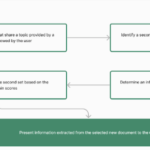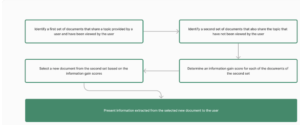This guide to entry-level jobs as a data analyst examines the types of jobs junior in data analytics, where you can find them, and the requirements and qualifications you’ll need to be able to get them.
If you’ve thought of the possibility of becoming a data analyst, there’s never a better time than now to start your new career track. Data analytics has a steep learning curve, particularly for those new to the field; however, it’s also gratifying financially and in terms of job satisfaction. However, since most jobs require some education before you even think to apply, you may be wondering about the current job market.
This article covers everything you’ll likely want to learn about entry-level data analytics jobs. In the end, you’ll know enough to either apply or move on to learning the skills you need.
- What does an entry-level analyst do?
All analysts working on data-related issues, irrespective of their experience levels, are working towards a common goal of analyzing data and generating valuable insights that propel an organization ahead. Naturally, the quality of the data (and the quality of information derived from the data) differs widely. It all depends on the specific goal you have (sales strategy or development of products?), the company you’re employed by (startup or a giant multinational? ), and the industry that you work in (healthcare or finance? ) as well as the job description and the line manager.
In general, the primary responsibility of junior data analysts is carrying out some of the tasks that are more “basic. However, as important as these tasks are, they often need to be considered within the overall analytical process of data analysis. This makes them more accessible for novice data analysts to tackle without an opportunity for costly mistakes. If you’re part of an organization (as most analysts do), you’ll most likely be monitored by a higher-ranking teammate. They’re responsible for keeping your work on track.
Considering all this, What exactly are the entry-level data analysts doing daily? Here are a few entry-level tasks related to data analytics that can be expected of you
- The process of collecting and storing data from a variety of sources
- Conducting exploratory data analysis (EDA)
- Recognizing patterns and trends in an array of data (or data sets)
- Cleaning and quality assurance of data are most often made using M.S. Excel formulas.
- Basic scripts written in Python and refactoring code by using Python programming language. Python programming language
- querying relational databases with Structured Query Language (SQL)
- Acquainting yourself with your specific business area (e.g., accounting, marketing, and product design) to gain a better understanding of the company and its goals
- In the process of experimenting with automation (although this is usually controlled or overseen by a more senior person)
- Designing visual dashboards that include tables, graphs, and other types of visualizations
- Reports and reports of your results
This list needs to be completed. The responsibility list will vary according to the elements previously mentioned. It’s nevertheless a good beginning point. Are there things on that list that you need to be aware of? Now is the time to start to know more!
- What are the industries in which entry-level data analysts do their work?
We now have a general idea of what the job of entry-level data analysts is and what kind of industry they work in. The good thing is that nearly all the industries you can imagine employ junior data analysts. Data is everywhere in our lives, particularly online. In addition, sectors as diverse as retail and finance use the power of prediction from these data.
However, the following industries are primarily involved in data-based analytics. If you’re searching for an entry-level job, one of these industries can be a good start:
Insurance
Within the insurance industry, risk analysis is an essential ability. So, firms are always looking for skilled analysts. LV=, Allianz, and the Zurich Insurance Group are just a few examples of insurance firms that employ data analysts with entry-level positions.
Finance
In the field of finance, data analytics plays a part in the development of products and sales strategies. Additionally, it is employed to detect fraud. Banks such as Barclays, Bank of America, Deutsche Bank, and companies such as PayPal and American Express are constantly seeking skilled analysts worldwide.
Professional and accounting services
The most significant accounting firms in the world have a mission to change their clients’ businesses. The “big four” accounting businesses ( PwC, KPMG, EY, and Deloitte) have been utilizing extensive data for a long time. They primarily recruit students for entry-level positions in data analysis because what they do demands special knowledge and skills. They also offer a lot of opportunities for career advancement.
The major tech firms we are familiar with are among the best-known supporters of data analysis. Google, Apple, Microsoft, Amazon, and Facebook are always looking for essential data analysts who can train in the ever-growing array of business sectors within which they work.
Beyond these, industries such as I.T., retail education, agriculture, and sciences constantly seek junior data analysts.
- What types of entry-level data analyst positions are there?
We’ve looked at the industries with the most sought-after data analysts. However, what opportunities are open? Are there other options for getting your foot into the door? (Okay, this is a logical inquiry; there is a solution!)
Internships in Data Analytics
One method of getting practical data analytics experience is looking for an internship. Companies with large budgets, particularly ones that hire new graduates and students, provide students with a glimpse of what a job is like.
If you do well in your internship, you could also have the chance of securing full-time employment. Suppose this is a career path that interests you. Why don’t you seek out a business you’d like to join and get in touch with your chief data scientist director of the analytics and data science department to find out whether they’re willing to accept an intern? There’s one thing you should be aware of many firms need to offer their employees a wage. We’re not a fan of this. However, it’s your choice if you’re content working for free to build your experience. There’s no one to be judging you for it.
Apprenticeships in Data Analytics
If you’re not a fan of the concept of an internship, then think about an apprenticeship. Many community colleges and vocational training institutions have connections to local business associations and allow you to develop the required data analytics skills in the classroom before applying them in an actual work context through an apprenticeship.
The benefit of apprentices is they prepare you for a specific company and introduce you to how the company operates. Apprenticeships are usually paid, and that’s a plus!
A third option gaining popularity for more advanced skills is degree apprenticeships. These offer more extensive training (over the years, not in months or weeks) and come with an apprenticeship or two. It not only provides you with the most in-depth knowledge but also lets you work for a variety of employers.
Other entry-level job names to be on the lookout for
When you begin searching for entry-level jobs that require data analytics, be aware that job titles may not be identical. They can differ significantly in line with the sector and the job description. Here are some examples to be aware of, as well as a brief explanation of what they do
- Marketing analysts in junior marketing use data to comprehend a specific market to help their company better position itself against rivals.
- Entry-level analyst for customer experience: This role involves measuring customer satisfaction using things such as their purchases and previous interactions with brands.
- Novice healthcare analystHealthcare analysts utilize information from pharmaceuticals and medical studies to develop new products or enhance clinical patient outcomes.
- Senior Operations Analyst Operations analysts aid in the resolution of real-world problems related to how a company is managed (e.g., how different departments interact).
- Business analyst entry-level: A business analyst helps improve the efficiency of an organization’s internal processes like hiring, H.R. procedures, or project management.
- Junior sports analystA sports analyst is an exciting job that requires them to monitor, record, and analyze the performance of athletes and coaches before suggesting ways to enhance their performance.
- Risk analyst at entry level: A risk analyst utilizes data to evaluate the advantages and disadvantages of various business choices (e.g., whether to provide insurance to a customer to insure them or not).
These examples provide a glimpse into the variety of job titles you could encounter. If a title for a job doesn’t tell you if the job is entry-level as well, make sure you keep attention on the tasks within your job description.
- Examples of entry-level data analysts’ job descriptions
We’ll concentrate on two data analysts who are entry-level advertisements taken directly from job websites. One is aimed at a small startup. Another is for a big company that you’ve heard of! Let’s look at it.
One example: Business analyst level 1 in a small startup
The first ad for a job we’ll look at is for a Level 1 business analyst for an entrepreneur-run company in California. It is part of the Bayen Group, specializing in automation, system integration, and SharePoint development. SharePoint is a web-based collaborative platform if you need to be made aware. It’s utilized in numerous offices to store data, analyze, and do other things.
After reading the job description and responsibilities, one can conclude that the job ad is for an entry-level position. It clearly states there is no requirement for experience. The job description stresses skills like problem-solving, a keen eye for particulars, strong writing and verbal communication skills, and more.
As a role for a data analyst, I need to catch up on the data analytics aspect itself. This is in line with the fact that for jobs that require junior data analysts, employers are more concerned with employability capabilities than analytics knowledge, which could be acquired in the workplace.
As you can see, the duties are less focused on the technical skills required to analyze data rather than being aware of what the company is doing and the best way to assist the company’s clients and other stakeholders. Although working alongside an experienced business analyst suggests that you can experiment with data, this isn’t the main focus of this entry-level position.
In the next section, the advertisement asks for tools such as M.S. Word, Excel, and SharePoint. Without mentioning programming tools, this suggests you’ll learn these skills while working, even with little technical knowledge. The salary is stated to range from $40,000 to $50,000. This perfectly aligns with our entry-level average analyst salary estimate, outlined in section 7.
Another example is a product analyst in a major company.
The other job ad we’ll examine is for a London-based product analyst based in London. The position is with Stadia Google’s gaming cloud service. This job requires more knowledge of data analytics than the previous example but still falls in the category of an entry-level position. This is because the section on responsibilities for this job is restricted to data analytics tasks for juniors and includes:
- Designing and modifying dashboards for your organization
- Reviewing the results of regular reviews with executives and other stakeholders.
- Conducting an in-depth analysis to uncover opportunities and potential risks
- Information on market dynamics
- Recommending based on the business context and data
In this case, we see more emphasis on data analysis and technical abilities than in the startup job. This shouldn’t be a surprise because Google is a more prominent company. More competitive jobs require more capabilities. Programming tools such as Python, the ability to work with SQL and knowledge of stats are all included as basic requirements. It’s good to know that these are capabilities you can learn by taking a high-quality online course that is certified. This job ad does not offer a salary estimate; however, when you’re the position being a Google subsidiary, that’s a sure bet that it’s a decently paid job.
Based on these two cases, it is clear that there are many different paths to data analytics. Try to find a large company like Google, and you’ll need to make a little more effort to acquire the necessary abilities (i.e., certified apprenticeships or courses). However, if you’re willing to accept an arduous learning curve on your job, then the right startup job could be the best option for you. Whatever you choose, you’ll be learning plenty!
- Where to find junior-level and entry-level job openings for data analysts
In the final section, we gave two examples of genuine job descriptions for entry-level data analysts. The best way to learn about the various roles of junior data analysts is to go through the job descriptions you have written on your own. Research is essential for every data analyst, so you should consider this method!
To assist you in finding a job, the following websites provide a wide range of jobs for data analytics professionals at entry level (of various quality). It is important to note that we’ve looked explicitly for ‘data analyst jobs.’ Be sure to conduct some searches on the field of interest, e.g., health analytics or business analytics.
- Data analyst jobs for entry-level positions on Indeed.com
- Entry-level data analyst jobs at Glassdoor.com
- Data analyst jobs for entry-level positions are available at Ziprecruiter.com
- Data Analyst jobs for entry-level positions at Linkedin.com
- Data Analyst jobs in entry-level levels on Monster.com
Although these general job websites offer more entry-level jobs, looking at job boards targeted explicitly towards jobs in data is worthwhile.
- What skills and qualifications are required to apply for (and be successful in landing) an entry-level job as a data analyst?
In section 4, we discussed that the competencies you require to be hired for an entry-level data analyst position will depend on the employer and the job description. Smaller startups that focus on hands-on learning may choose to employ essential data analysts who don’t have a significant amount of knowledge or experience. Instead, you’ll have to learn these skills as you go along.
If this is the case, what qualifications do these employers want? Simply put, they’ll want to see broad skills that prove your capacity and willingness to take on new challenges. Examples:
- Problem-solving and decision-making
- Critical and imaginative thinking
- Excellent interpersonal and communication skills
- Empathy and self-awareness
- Inspiring and motivation
- Leadership and teamwork
- Resilience and dependability, e.g., capacity to handle stress
Most of the time, to secure your first entry-level job, you’ll need to supplement the ‘life skills’ you have acquired by acquiring technical skills. This is especially true for larger companies that expect you to perform well. In this scenario, the most likely requirement is:
- A bachelor’s degree is required, which should be in a computer science-related discipline.
- Expertise in statistical programming, e.g., Python or R
- Experience with relational databases and SQL
- Expertise in using M.S. Excel and its statistical functions
- The ability to design data visualizations with the help of software such as Tableau
- Strong skills in statistics and math
- The theory of machine learning and automation (an advantage; however, it is not a requirement for entry-level jobs as a data analyst)
These are the kinds of qualifications that employers are looking for. However, as always, you must ensure you take the time to read the job description thoroughly.
- What is the typical starting salary for a data analyst?
Now, we can get to the most critical questions: What is the average salary for entry-level jobs for data analysts?
By taking an average from U.S. entry-level data analyst salary (according to wage and job comparators such as Indeed, Glassdoor, SimplyHired, Salary.com, Salary Expert, and Payscale), We can conclude that junior analysts make around $46,000 per year across the U.S., which is decent for an entry-level position.
Many aspects, other than your expertise level, affect how much you earn, including the sector you’re in, the area of your job, and even the team size. It is possible to get a sense of the amount an individual data analyst at entry level could earn by analyzing various factors in this article.
For more information on the potential earnings as your career grows, read this article on salaries for data analysts. It provides general information for all roles, i.e., mid-level and senior roles and junior ones.
- The key takeaways and the next steps
You’re now equipped with everything you should know about entry-level jobs in the data analytics market! From the job description of an entry-level data analyst and the types of industries they work within to the requirements for the skills needed and the amount you could be paid, we’ve covered this comprehensive guide.


















